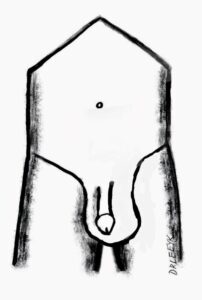
<Male left inguino-scrotal hernia>
Adult Inguinal Hernia
Symptoms
Complications

Risk factors
Diagnosis
Indication of surgery
Surgery
In the past, hernias were repaired by sutures and the recurrence rate was high, nearly 50%. Nowadays, using artificial mesh to fix the hernia is the standard of treatment, as artificial mesh repair can reduce the chance of recurrence to less than a few percent in ten years after surgery. Hernia artificial mesh repair may be done by:
- Traditional large incision open hernia repair surgery
- Small incision open hernia repair surgery
- (Minimal invasive) laparoscopic hernia repair surgery
Traditional large incision open hernia surgery with artificial mesh needs an incision of about 10–12 cm to fix the artificial mesh and repair the hernia.
Small incision open hernia repair surgery with artificial mesh needs an incision of about 3–5 cm to fix the artificial mesh and repair the hernia.
Minimal invasive laparoscopic hernia repair surgery with artificial mesh uses three to four small incisions (size 0.5–1 cm) to pass the instrument and videoscope to the preperitoneal area to fix the hernia with the artificial mesh.
Elective small incision open hernia repair surgery or minimal invasive laparoscopic hernia repair surgery use smaller wounds to fix the artificial mesh. The postoperative wound pain will be less, and patients can return to office work or exercise earlier. Most patients recover well and can go home one to two days after surgery. The outcome of these elective surgeries is usually very good, and the complication rate is very low.
Long-acting local anesthetic injections to the wound during surgery and postoperative oral analgesics are often used to reduce the postoperative wound pain to a minimum. Absorbable subcutaneous stitches are often used to close the hernia wounds, eliminating the need to suffer any pain during the removal of superficial stitches. Patients are usually required to keep the wound dry for 2–3 weeks. After 2–3 weeks, all the wound dressings can be removed. Patients can usually return to office work 1 to 2 weeks after surgery. Patients can often return to exercise 4 to 6 weeks after surgery.
In emergency surgery for strangulated hernia, traditional open surgery usually requires a large wound to gain access to the hernia sac, return the abdominal content to the abdomen, and fix the artificial mesh. If there is bowel obstruction or bowel perforation, major laparotomy and bowel surgery will be required to correct the problem. Emergency surgical repairs of strangulated hernias usually carry a higher complication risk, higher morbidity rate, and higher mortality rate. Patients with emergency hernia surgery often need to stay in the hospital for one to two weeks.
FAQs
A: Yes. You may choose not to treat your hernia. But you may feel pain or discomfort every time you stand or walk. As the condition worsens over time, you may face more serious complications such as intestinal ischemia, intestinal perforation, peritonitis, and even death. It is indeed unwise to leave it untreated.
Using the latest methods to treat inguinal hernia, most patients feel no pain or minor pain after surgery. Most patients can return to their favorite activities within 6 - 8 weeks. Why not seek early treatment?
Please consult your doctor for advice.
A: The latest artificial mesh repair surgeries for inguinal hernias are very safe. The operation takes about 1-2 hours, the postoperative pain is low, and the recurrence rate is low. Please consult your doctor for advice.
















